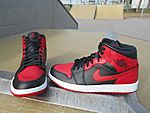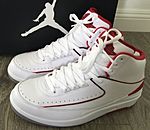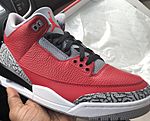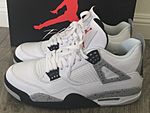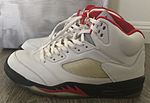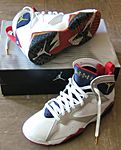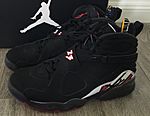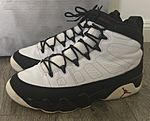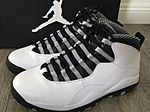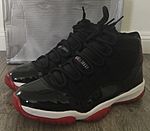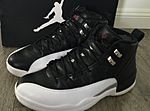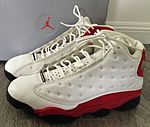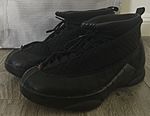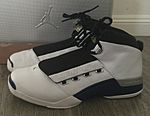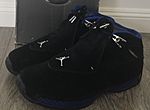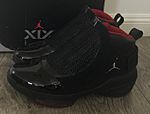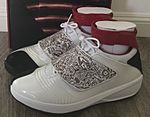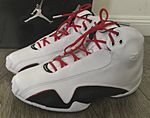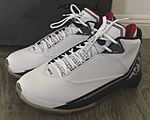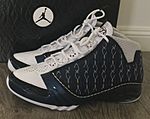Air Jordan facts for kids

The silhouette of Michael Jordan served as inspiration to create the "Jumpman" logo.
|
|
| Type | Basketball shoes, sportswear shoes and clothing |
|---|---|
| Owner | Nike |
| Country | United States |
| Introduced | November 17, 1984 |
| Markets | Worldwide |
Air Jordan is a famous line of sports shoes and clothing. It is made by Nike. The brand is named after the legendary basketball player, Michael Jordan.
The very first Air Jordan shoe was made for Michael Jordan on November 17, 1984. It was released to the public on April 1, 1985. Talented designers like Peter Moore, Tinker Hatfield, and Bruce Kilgore created these shoes. The well-known "Jumpman" logo comes from a photo of Michael Jordan.
Contents
The Story of Air Jordan
When Michael Jordan was a new player in 1984, big shoe companies wanted him to sign a deal. These companies were Adidas, Converse, and Nike. Nike showed Jordan a video of his amazing slam dunks. They also showed him the first design of the Air Jordan shoe. Jordan had some ideas for the colors. Nike listened to his feedback. They wanted to make him a unique star with his own shoe line.
On October 26, 1984, Michael Jordan signed a five-year deal with Nike. It was worth $2.5 million. This was three times more than any other deal in the National Basketball Association (NBA) at that time. Nike hoped to sell $3 million worth of shoes in the first three years. But sales were much better than expected! They earned $126 million in just one year.
The NBA had a rule about shoe colors. Shoes had to be 51% white. The Air Jordan I was designed with the Chicago Bulls' red and black colors. Only 23% of the shoe was white. This broke the NBA's rule. Nike agreed to pay the $5,000 fine for each game Jordan wore them. This created a lot of buzz and made the shoe even more famous. Nike even made an ad called "Banned." It said the NBA couldn't stop people from wearing them. The shoe sold 50,000 pairs and made over $150 million.
On September 9, 1997, Michael Jordan and Nike launched Jordan Brand. This brand has grown by selling Air Jordan shoes and clothes. It also works with popular artists. In 2022, Jordan Brand earned $5.1 billion for Nike. Michael Jordan himself received a large amount from this, between $150 million and $256 million.
The Jumpman Logo
The famous "Jumpman" logo comes from a photo. Michael Jordan posed for Life magazine. This was before he played for Team USA in the 1984 Summer Olympics. The photo was taken by Co Rentmeester. Jordan was doing a pose similar to a ballet move called a grand jeté. He was holding a basketball and wearing his Olympic uniform.
Later, Peter Moore, who led the design team, saw this photo. He asked Jordan to do the same pose again. This time, Jordan was in Chicago. He wore his Bulls uniform and Nike Air Jordan shoes. The "Jumpman" logo has changed over time. You can see it on sneakers, clothes, hats, and socks. It is now one of the most recognized logos in sports.
Air Jordan Shoe Models
| Model | Year | Cool Facts About Each Model |
|---|---|---|
| Air Jordan I | 1984 | This was the very first Air Jordan. Peter B. Moore designed it. Michael Jordan wore it during his second season with the Chicago Bulls. The red and black color was against NBA rules. |
| Air Jordan II | 1986 | This shoe was made in Italy. It was designed by Peter Moore and Bruce Kilgore. It was the first Jordan shoe without the Nike swoosh logo on the side. |
| Air Jordan III | 1988 | The Air Jordan III was the first shoe to feature the new Jumpman logo. |
| Air Jordan IV | 1989 | This was the first Air Jordan sold worldwide. Director Spike Lee helped promote it and featured it in his movie Do The Right Thing. Michael Jordan wore these when he made "The Shot" in a famous game. |
| Air Jordan V | 1990 | Designed by Hatfield, this shoe was inspired by a WWII Mustang fighter plane. It had a reflective tongue and clear soles. Will Smith wore these shoes often in the TV show The Fresh Prince of Bel-Air. |
| Air Jordan VI | 1991 | This shoe was inspired by a German sports car. Michael Jordan wore the VI when he won his first NBA championship with the Bulls. |
| Air Jordan VII | 1992 | The Air Jordan VII used "huarache" technology for a better fit. It was the first model without the "Nike Air" logo on the outside. Jordan wore a special Olympic version with his jersey number 9 for the "Dream Team". |
| Air Jordan VIII | 1993 | This model had two crossover straps. It was famous for ads where Bugs Bunny appeared with Michael Jordan. |
| Air Jordan IX | 1993 | This was the first Jordan shoe released after Michael Jordan retired from basketball. He never played an NBA game in them. The design was inspired by baseball cleats. |
| Air Jordan X | 1994 | This shoe showed all of Michael Jordan's achievements up to his first retirement on its sole. It was released in colors representing different U.S. cities. |
| Air Jordan XI | 1995 | Tinker Hatfield designed this shoe hoping Jordan would return to basketball. It was made lighter and more durable with mesh. The shiny patent leather gave it a "formal" look. Jordan wore these when the Bulls won the 1995–96 NBA Championship. |
| Air Jordan XII | 1996 | The Air Jordan XII had a "Rising Sun" design. This looked like the Flag of Japan. |
| Air Jordan XIII | 1997 | This model was inspired by a black panther. The sole looked like a panther's paw. A hologram on the back looked like panther eyes. In 2023, a pair of Jordan's game-worn Air Jordan 13s sold for $2.2 million, a record for sneakers. |
| Air Jordan XIV | 1998 | This shoe was inspired by the Ferrari 550 M car that Michael Jordan owned. It was nicknamed "The Last Shot." Jordan wore them when he made his game-winning shot in his final game with the Chicago Bulls. |
| Air Jordan XV | 1999 | This was the first shoe released after Jordan's second retirement. Its design was inspired by the North American X-15 jet. |
| Air Jordan XVI | 2001 | This shoe came with removable covers called spats. Its design was inspired by fast cars and buildings. |
| Air Jordan XVII | 2002 | This pair of Jordans came with a CD-ROM that had an Air Jordan XVII song. Michael Jordan wore these when he played for the Washington Wizards. |
| Air Jordan XVIII | 2003 | This shoe was released during Michael Jordan's very last season playing for the Washington Wizards. Its design was inspired by F1 race cars and Italian dress shoes. |
| Air Jordan XIX | 2004 | This was the first Jordan shoe released after his third and final retirement. The design was inspired by the black mamba snake. These are known as the lightest Air Jordans ever made. |
| Air Jordan XX | 2005 | The Air Jordan XX was inspired by motorcycle shoes. Jordan had started motorcycle racing. It had a strap over the laces for a tighter fit. |
| Air Jordan XXI | 2006 | This shoe was inspired by sports cars. It came with parts you could remove to make the cushioning firm or soft. |
| Air Jordan XX2 | 2007 | The XX2 was inspired by the F-22 Raptor fighter jet. |
| Air Jordan XX3 | 2008 | This was the first basketball shoe in Nike's "Considered" category. This meant it used materials from nearby factories. It was the last Air Jordan to use Roman numerals until the XX8. |
| Air Jordan 2009 | 2009 | This was the first Air Jordan named after its release year instead of a number. It was inspired by Jordan's focus on defense. |
| Air Jordan 2010 | 2010 | This shoe was released for the 25th anniversary of the Air Jordan brand. The sole had a famous quote from Michael Jordan about how his failures led to his success. |
| Air Jordan 2011 | 2011 | This shoe had interchangeable insoles. A red one was for power, and a blue one was for quickness. It also had a star pattern for ventilation. |
| Air Jordan 2012 | 2012 | The Air Jordan 2012 offered six ways to customize it. It had two different sleeves and three insoles. This was the last Air Jordan named after its release year. |
| Air Jordan XX8 | 2013 | This shoe had an outer cover made from a special Swiss fabric. This fabric is used for motorcycle jackets. |
| Air Jordan XX9 | 2014 | This shoe had a special woven upper part. Some areas were stiff, and others were flexible. It was worn by NBA players like Russell Westbrook. |
| Air Jordan XXX | 2016 | This shoe had an upper and outsole similar to the XX9. The ankle collar was made with a special knit. |
| Air Jordan XXXI | 2016 | This shoe was heavily inspired by the original Air Jordan 1s. It had leather and the Jumpman logo. It was released for the 30th anniversary of the NBA banning the Air Jordan 1. |
| Air Jordan XXXII | 2017 | The Air Jordan XXXII was influenced by the Air Jordan 2. It also included the Jordan "Wings" logo. |
| Air Jordan XXXIII | 2018 | This was the first Air Jordan model that did not have laces. |
| Air Jordan XXXIV | 2019 | This shoe was released with special details. These details celebrated the brand's 30th anniversary. |
| Air Jordan XXXV | 2020 | This model focused on being lightweight. It had a unique hole in the middle of the foot for stability and bounce. NBA players like Jayson Tatum wore them. |
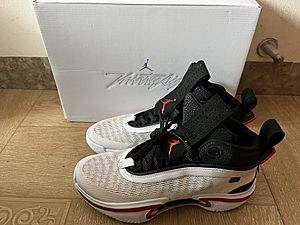 Air Jordan XXXVI Air Jordan XXXVI |
2021 | This shoe was first shown by basketball player Satou Sabally. It made its first appearance on the court in March 2021. |
| Air Jordan XXXVII | 2022 | The Air Jordan XXXVII was released in July 2022. |
| Air Jordan XXXVIII | 2023 | This shoe has a special Cushlon 3.0 midsole. It was released in August 2023. |
| Air Jordan XXXIX | 2024 | The Air Jordan XXXIX was released in July 2024. |
Other Cool Air Jordan Shoes
Special Shoe Packs
- "Spizike"
The Jordan Spiz'ike shoes came out in 2006. They honored the friendship between Michael Jordan and director Spike Lee. Spike Lee's character, Mars Blackmon, was in many Nike ads for Air Jordans. The Spiz'ike mixes parts from the Jordan III, IV, V, VI, and XX shoes.
- "Defining Moments"
This pack came out in 2006. It included shoes Michael Jordan wore when he won his first championship in two of his "three-peats." These are considered very rare.
- "Defining Moments II"
This pack was inspired by the Running of the Bulls in Spain. It had two Air Jordan 5s. One was red suede, like the bandanas worn by runners. The other was reflective.
- "Defining Moments III"
This pack was released in 2009. It was inspired by a game where Jordan scored 63 points against the Celtics. It included a re-release of the shoes Jordan wore in that game. It also had a shoe inspired by the Celtics' colors.
- Retro 6 Infrared Pack
This pack was released in 2013. It included two classic colorways of the Air Jordan 6.
- "Old Love New Love"
This two-pair pack came out in 2007. It had two Air Jordan I Retro shoes. One was an original color, and the other was new. The pack showed Jordan's two main passions: basketball (old love) and motorcycle racing (new love).
Jordan "6 Rings" Shoe
The Jordan 6 Rings shoe combines parts from seven different Air Jordan shoes. Michael Jordan wore these seven shoes during his six championship seasons. These include the Air Jordan 6, 7, 8, 11, 12, 13, and 14. The Jordan Brand started releasing these shoes in 2008.
The shoes come in colors that represent the teams the Chicago Bulls beat in their six championships. These teams were the Los Angeles Lakers, Portland Trail Blazers, Phoenix Suns, Seattle SuperSonics, and Utah Jazz. There's also a "winterized 6 rings" version. This is a tougher boot designed for outdoor use.
Air Jordan's Impact on Culture
Air Jordans are a huge part of "sneaker culture" today. People all over the world wear them. Air Jordans have gone beyond just basketball. They are now important in fashion, pop culture, and hip-hop. They are a key part of casual and streetwear styles.
The shoes became even more popular because of their connection to hip-hop music since 1985. Rappers like 2Pac, The Notorious B.I.G., Ice Cube, and Jay-Z mentioned Air Jordans in their songs. You can also see them on album covers and in music videos. Many artists and celebrities wear them every day. When hip-hop artists like Travis Scott work with Jordan Brand, it makes the shoes even more popular. Air Jordans have become a symbol of status.
Collecting Sneakers
Air Jordans played a big role in the rise of "sneakerhead" culture. In the 1980s, collecting, trading, and reselling sneakers became popular. As new models came out, more Air Jordans became highly desired for collections. Reselling Air Jordans can be very profitable. Rare sneakers can sell for hundreds or thousands of dollars. For example, an original 1985 Air Jordan I sold for up to $20,000. The sneaker resale market is huge. It is expected to grow even more in the coming years.
Working with Other Brands and Artists
Air Jordan has teamed up with many famous people and brands. These include celebrities like Drake, Billie Eilish, J Balvin, DJ Khaled, Eminem, Nicki Minaj, and Mark Wahlberg. Rapper Travis Scott designed his own "Cactus Jack" versions of Air Jordan shoes.
Air Jordan has also worked with streetwear brands, fashion houses, and even soccer clubs. Some of these collaborations include Virgil Abloh's brand Off-White, Supreme, Commes de Garcons, Kaws, Dior, and Paris Saint-Germain.
Air Jordans in TV and Movies
Air Jordans have appeared in many TV shows. In The Fresh Prince of Bel-Air, Will Smith wore different models of the shoes. The show's impact led Jordan Brand to release special Air Jordan Vs related to the show.
Films have also influenced Air Jordan designs. In the 1989 movie Do the Right Thing, a character's clean Air Jordan 4s got scuffed. Jordan Brand later released a Jordan 4 that looked like those scuffed shoes. Air Jordans have been in other movies too, like He Got Game (1998) and Space Jam (1996).
Looney Tunes and Space Jam
In 1992, Jordan Brand aired a commercial during the Super Bowl. It showed Bugs Bunny asking Michael Jordan for help. This led to the movie Space Jam (1996). The movie was a huge success. It earned over $230 million and sold over $1 billion in merchandise. This helped make Looney Tunes characters popular in street fashion. A sequel, Space Jam: A New Legacy, came out in 2021.
Air
Air is a movie from 2023. It tells the true story of how Air Jordan began. The film shows how a Nike employee, Sonny Vaccaro, worked to get Michael Jordan to sign with Nike. Matt Damon plays Sonny Vaccaro.
Like Mike
Like Mike is a sports comedy movie from 2002. It's about a teenage orphan who gets amazing basketball skills. This happens when he wears sneakers that belonged to Michael Jordan.
Air Jordan Sponsorships
Since 1997, Air Jordan has sponsored many college sports teams. They first sponsored the Cincinnati Bearcats, St. John's Red Storm, and North Carolina A&T Aggies.
In 2016, Air Jordan started providing gear for the Michigan Wolverines football team. This was the brand's first time in a sport other than basketball. As of 2023, Air Jordan also sponsors football teams like the North Carolina Tar Heels and Oklahoma Sooners.
In 2018, the Jordan brand sponsored a association football (soccer) club for the first time. The French club Paris Saint-Germain F.C. wore the Jumpman logo on their jerseys.
The Jordan brand also sponsors 23XI Racing. This is a NASCAR team partly owned by Michael Jordan.
American Football Teams and Players
College Football Teams
- University of Florida
- Howard University
- University of Michigan
- University of North Carolina at Chapel Hill
- University of Oklahoma
- University of California, Los Angeles
NFL Players
- Jalen Hurts
- Dak Prescott
- Davante Adams
- Stefon Diggs
- Jarvis Landry
- Chase Claypool
- Sterling Shepard
- Kyle Pitts
- Melvin Ingram
- Bobby Wagner
- Devin White
- Dont'a Hightower
- Stephon Gilmore
- Jamal Adams
- Tyrann Mathieu
- Deebo Samuel
- Bryce Young
Soccer Teams
Club Teams
Auto Racing Teams and Drivers
NASCAR Teams
- 23XI Racing
NASCAR Drivers
- Kurt Busch
- Denny Hamlin
- Tyler Reddick
Baseball Players
MLB Players
- Mookie Betts
- Jazz Chisholm Jr.
- Vladimir Guerrero Jr.
- Aaron Hicks
- Aaron Judge
- Derek Jeter
- Manny Machado
- Yadier Molina
- CC Sabathia
- Taijuan Walker
- Elly de la Cruz
Basketball Teams and Players
National Teams
 Croatia
Croatia France
France Slovenia
Slovenia Japan
Japan
College Teams
- University of Cincinnati
- University of Florida
- Georgetown University
- University of Houston
- Howard University
- Marquette University
- University of North Carolina
- University of Oklahoma
- San Diego State University
- University of California, Los Angeles
NBA Players
WNBA Players
- Jordin Canada
- Te'a Cooper
- Crystal Dangerfield
- Stefanie Dolson
- Chelsea Dungee
- Asia Durr
- Dana Evans
- Dearica Hamby
- Isabelle Harrison
- Arella Karin Guirantes
- Maya Moore
- Kia Nurse
- Aerial Powers
- Satou Sabally
Professional Wrestling
- Roman Reigns
- Bryan Danielson
Giving Back: Philanthropy
The Jordan Brand works with organizations like the UNCF. They help fund college education for young people who need support.
The brand also makes large donations to communities, athletes, and schools. They promise to help with important issues in Black communities. This includes supporting economic fairness, education, and social justice for young people.
More to Explore
- Flu Game shoes
- List of basketball shoe brands
- Nike Air Max
- Nike Blazers


